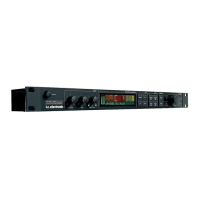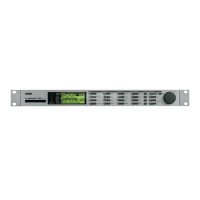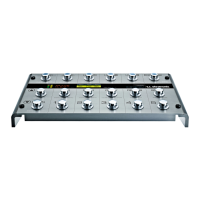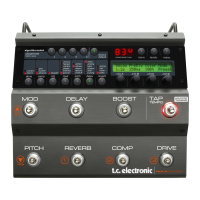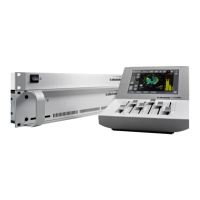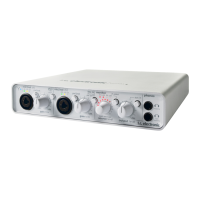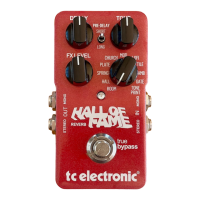21 TC2290 User Manual
MIX
The last parameter to adjust a basic delay setting is the MIX between the echoes
and the direct signal. To access this parameter, press SPEC twice and use the
UP/DOWN arrows to set the MIX.
Alternatively, the MIX setting can be adjusted using the plug-in UI.
If using the plug-in as an insert on a channel, you will likely want a setting
below 50% to avoid a muddy-sounding result. However, if using the plug-in as a
send/aux eect, set the MIX to 100%.
6.2 Modulation Eects
The TC2290 has 3 kinds of modulation eects available:
• • Delay Time modulations – chorus, anger, pitch modulation,
auto-doubling eects.
• • Dynamic modulations – tremolo, compress/expand,
ducking/gating eects.
• • Pan position modulations – auto-panning eects.
Each of these eects has its own MOD on/o button.
The parameters for each of these modulations are controlled in the MODULATION
section on the hardware unit. By using the SELECT button within this section,
you can scroll through the 3 types of modulation.
After the modulation type has been selected, the 3 parameters in this section can
be adjusted, which are:
WAVEFORM – determines the modulation waveform, between sine wave (SINE),
random wave (RAND), input signal envelope controlled (ENV), or input
level triggered (TRIG). The modulation target determines the function of
ENV and TRIG.
SPEED – Pressing UP or DOWN once will bring focus to the SPEED parameter,
and additional presses will move the value by one step. The SPEED parameter is
shown in Hz (cycles per second).
Depending on the modulation target, when the ENV or TRIG Waveform is
selected, the SPEED parameter controls the rate of change from no eect to
maximum eect. A setting of “1” means a ramp time of 1 second, whereas a
setting of “5” means a ramp time of ⁄ of a second.
DEPTH – Pressing UP or DOWN once will bring focus to the DEPTH parameter,
and additional presses will move the value by one step. The DEPTH value is
displayed in percentage of maximum modulation.
Pressing the SPEED or DEPTH arrow keys will rst bring focus to that parameter,
causing a green LED to ash above and the display to show the current value.
This means the arrow buttons can change the value by single steps, and also
allows a specic value to be entered on the KEYBOARD, followed by the
ENTER key.
Note- the feedback parameter of the delay may also have an eect on
modulation eects.
Each of these parameters aects the sound dierently depending on the
specic eect. Let’s review each type of modulation and how it can be adjusted.
6.2.1 Dynamic Eects
In the MODULATION section, use the SELECT button to highlight the
Dynamics (DYN) parameters. Ensure that the MOD button is engaged in the
center PAN/DYN section.
Ducking Delay
A ducking delay uses the input signal to attenuate the delay signal, causing the
echoes to stay “out of the way” while you’re playing, but still allow the echo tails
to be audible during gaps in your playing.
Press the WAVEFORM button until TRIG is selected. This selects the
ducking eect.
Press the DEPTH UP or DOWN button to shift focus to this parameter. The green
LED will ash above and the current value is displayed. This parameter controls
how much the delay signal is attenuated. Lower the value for small amounts of
attenuation, or raise it to make the eect almost inaudible while you’re playing.
Press the SPEED UP or DOWN button to shift focus to this parameter. This controls
the rate at which the attenuation is released. Lower values allow a longer period
of time to pass after you stop playing before the echoes increase to their normal
volume. Higher values let the echoes come in quickly.
Gated Delay
By pressing the REVERSE button in the PAN/DYN section, the ducking eect
becomes a gated delay. Set this way, the eect will only be heard while you
are playing, and will be attenuated when you stop.
Tremolo Eect
Press the WAVEFORM button until SINE or RAND are selected. This creates
a tremolo eect where the volume of both the direct and delay signals are
attenuated and then return to full volume, up and down at a constant rate
(SINE only). Use the SPEED parameter to adjust the specic rate, and the DEPTH to
adjust the amount of attenuation.
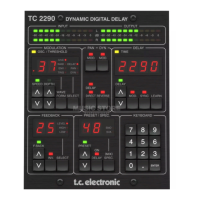
